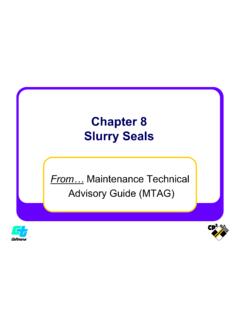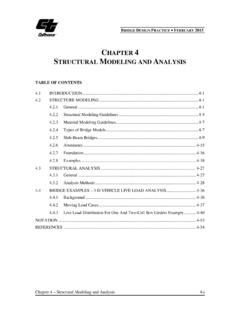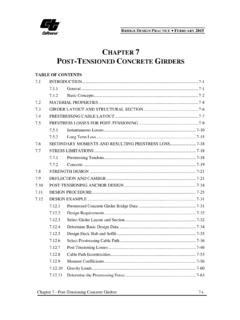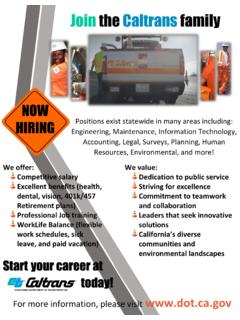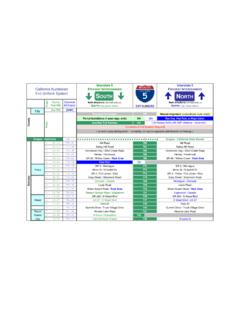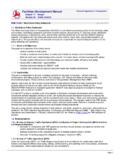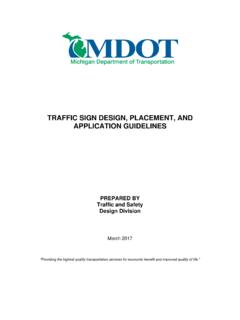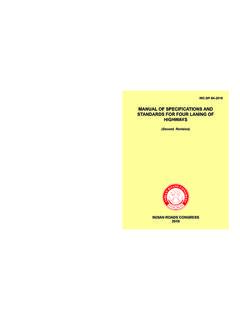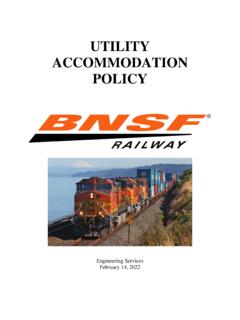Transcription of CHAPTERS 800 890 HIGHWAY DRAINAGE DESIGN CHAPTER …
1 HIGHWAY DESIGN Manual 800-1. July 1, 2020. CHAPTERS 800 890 HIGHWAY . DRAINAGE DESIGN . CHAPTER 800 GENERAL ASPECTS. Topic 801 General Index Introduction This section is not a textbook, and is not a substitute for fundamental engineering knowledge or experience. The fields of hydrology and the hydraulics of HIGHWAY DRAINAGE are rapidly evolving and it is the responsibility of the engineer to keep abreast of current DESIGN practices. As new practices or procedures are adopted by the Department, this section will be updated. Instructions for the DESIGN of HIGHWAY DRAINAGE features provided are for information and guidance of Department employees. DRAINAGE policies, procedures and standards given are subject to amendment as conditions warrant and are neither intended as, nor do they establish, legal standards.
2 Special situations may call for variations from these requirements, subject to approval of the Division of DESIGN or approval by others as may be specifically referenced. DRAINAGE DESIGN Philosophy HIGHWAY DRAINAGE DESIGN is much more than the mere application of the technical principles of hydrology and hydraulics. Good DRAINAGE DESIGN is a matter of properly balancing technical principles and data with the environment giving due consideration to other factors such as safety and economics. Such DESIGN can only be accomplished through the liberal use of sound engineering judgment. DRAINAGE features to remove runoff from the roadway and to convey surface and stream waters originating upstream of the HIGHWAY to the downstream side should be designed to accomplish these functions without causing objectionable backwater, excessive velocities, erosion or unduly affecting traffic safety.
3 A goal in HIGHWAY DRAINAGE DESIGN should be to perpetuate natural DRAINAGE , insofar as practical. DRAINAGE Standards DRAINAGE DESIGN criteria should be selected that are commensurate with the relative importance of the HIGHWAY , associated risks, and possible damage to adjacent property. The objective of DRAINAGE DESIGN should be to provide optimum facilities considering function versus cost rather than to just meet minimum standards. Engineers and other professional disciplines using this guide must recognize that hydrologic analysis, as practiced by the HIGHWAY engineer, has not advanced to a level of precise mathematical expression. All hydrologic analysis methods, whether deterministic 800-2 HIGHWAY DESIGN Manual July 1, 2020.
4 Or statistical, are based on the information available. A common challenge faced by the HIGHWAY DESIGN engineer is that there may be insufficient flow data or no data at all at the site for which a stream crossing is to be designed. By applying analytical principles and methods it is possible to obtain peak discharge estimates which are functionally acceptable for the DESIGN of HIGHWAY DRAINAGE structures and other features. The DESIGN of HIGHWAY DRAINAGE structures and other features must consider the probability of flooding and provide protection which is commensurate with the importance of the HIGHWAY , the potential for property damage, and traffic safety. Traditionally, the level of assurance for such protection has been specified in terms of the peak rate of flow during passage of a flood or storm of the severity associated with the frequency of occurrence, a 10-year storm, the 50-year flood, etc.
5 State-of-the-art methods and procedures associated with the necessary hydrologic analysis required to determine the severity and probability of occurrence of possible rare storms and flood events are inherently ambiguous. Therefore, the suggested DRAINAGE DESIGN criteria relating to frequency of occurrence references in this manual are provided for guidance only and are not intended to establish either legal or DESIGN standards which must be strictly adhered to. Rather, they are intended as a starting point of reference for designing the most cost effective DRAINAGE structures and facilities considering the importance of the HIGHWAY , safety, legal obligations, ease of maintenance, and aesthetics.
6 Objectives of DRAINAGE DESIGN DRAINAGE DESIGN seeks to prevent the retention of water by a HIGHWAY and provide for removal of water from the roadway through a detailed analysis considering all pertinent factors. Specific steps to be taken generally include: (a) Estimating the amount and frequency of storm runoff. (b) Determining the natural points of concentration and discharge, the limiting elevations of entrance head, and other hydraulic controls. (c) Estimating the amount and composition of bedload and its abrasive and bulking effects. (d) Determining the necessity for protection from floating trash and from debris moving under water. (e) Determining the requirements for energy dissipation and bank protections.
7 (f) Determining the necessity of providing for the passage of fish and recognizing other ecological conditions and constraints. Water quality and pollution control are discussed under Index Aspects of wetlands protection are covered under Index (g) Analyzing the deleterious effects of corrosive soils and waters on structures. (h) Comparing and coordinating proposed DESIGN with existing DRAINAGE structures and systems handling the same flows. (i) Coordinating, with local agencies, proposed designs for facilities on roads to be relinquished. (j) Providing access for maintenance operations. HIGHWAY DESIGN Manual 800-3. July 1, 2020. (k) Providing for removal of detrimental amounts of water on traveled ways (see Topics 831 and 833).
8 (l) Providing for removal of detrimental amounts of subsurface water. (m)Designing the most efficient DRAINAGE facilities consistent with the factors listed above, economic considerations, the importance of the transportation facility, ease and economy of maintenance, engineering judgment, and aesthetics. (n) Checking the structural adequacy of designs by referral to Structures DESIGN or by use of data furnished by Structures DESIGN . (o) Preventing water from crossing slopes in concentrated flows. Economics of DESIGN An economic analysis of alternate DRAINAGE designs, where a choice is available, should always be made. Non-engineering constraints may severely limit the DESIGN alternatives available to the DRAINAGE DESIGN engineer for a specific project or location.
9 Generally, however, the DESIGN engineer has a wide range of materials and products to choose from in selecting the most economical DESIGN from available alternatives for HIGHWAY DRAINAGE structures and other features. The following factors should be considered in the selection of alternative designs and economic comparisons: (a) Initial cost of construction and right of way. (b) Evaluation of flood related risks to the HIGHWAY and to adjacent properties including potential liabilities for damage. (c) Cost of detours and traffic handling. (d) Service life of the HIGHWAY and of the DRAINAGE structure. (e) Cost of providing traffic safety features. (f) Aesthetics. (g) Costs to traveling public for delays or extra travel distance due to road closures.
10 (h) Initial cost versus long term maintenance costs for cleanout, repair, traffic control and other pertinent maintenance charges that may be incurred during the life of the facility. (i) Safety of required maintenance activities, ability to provide maintenance mechanically and to reduce worker exposure. (j) Inlet and outlet treatment. (k) Potential for causing erosion and effective water pollution control. Use of DRAINAGE References No attempt has been made herein to detail basic hydrologic and hydraulic engineering techniques. Various sources of information, including FHWA Hydraulic Engineering Circulars (HEC's);. Title 23, Code of Federal Regulations (CFR), Part 650, Subpart A; AASHTO Guidelines.

